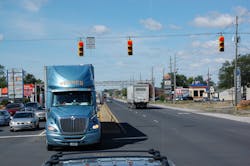Reforms made to hours of service (HOS) regulations imposed back in July are one of several factors starting to affect the profitability of carriers, particularly those in the long-haul TL segment of the industry.
“Cost pressures within the TL space appear to be rising more quickly than pricing increases,” noted Benjamin Hartford, an analyst with Wall Street firm Robert W. Baird & Co., in a recent freight update, adding that productivity drags from the recently implemented HOS mandates, higher maintenance/equipment costs, and rising driver-related costs are all part of that cost-pressure mix.
Hartford also noted that after freight volumes strengthened in August, growth appears to be resuming in his words a “decelerating” trend.
“Despite inflecting positively in August, the U.S. PMI [purchasing manager’s index] and New Orders readings [regarding industrial demand] appear entrenched in a downward-sloping trajectory. Similarly, the recent run-ups in commodities prices have stalled, which limits the upside potential for freight volumes, in our view,” he noted. “The government shutdown [also] presents a wildcard to fourth quarter demand outlook. At this moment, we see few catalysts supporting reaccelerating volume growth in 2014.”
Werner Enterprises noted that the HOS changes, in particular, affected its ability to generate revenue-bearing miles for its fleet.
“Average monthly miles per truck declined by 3.5% in third quarter of 2013 compared to third quarter of 2012 and declined by 2.3% compared to second quarter of 2013,” the TL carrier noted in its earnings report. “As expected, the company believes that HOS changes negatively impacted miles per truck by 2% to 3%. In addition to the HOS changes, truck mix changes (more dedicated, less one-way TL) and a 7% shorter length of haul in third quarter of 2013 compared to third quarter of 2012 also contributed to the lower miles per truck.”
Kevin Knight, chairman and CEO of Knight Transportation, noted in a third quarter earnings guidance release earlier this month that “a number of factors negatively impacted” the carrier’s third quarter earnings outlook, with HOS changes one of the culprits.
“We experienced lower miles per tractor year over year, despite having 3.6% less trucks in the third quarter of 2013 than in the third quarter of 2012, revenue per mile improvement fell short of our targeted level, and increased driver recruiting, training, and payroll costs,” he explained. “Soft freight demand, particularly in the first half of the quarter, challenges related to recruiting qualified driving associates, and the new industry-wide regulations governing HOS that went into effect in July were among the factors affecting the quarter.”
J.B. Hunt Transport Services noted that its TL division is also being negatively affected by the HOS changes, though the company overall posted higher earnings and revenues in the third quarter this year versus the same period in 2012 due to burgeoning intermodal and dedicated truck demand.
The carrier said its TL revenues in the third quarter decreased 17% from the same period in 2012, primarily from an 18% reduction in fleet size and lower utilization per truck. Favorable changes from lowering the size of the trailer fleet, fewer empty miles and reductions in office headcount were more than offset by lower tractor utilization from moderate customer demand and new HOS regulations, increased driver hiring costs, increased driver and independent contractor mileage pay and higher maintenance cost per unit, the company pointed out.
Still, J.B. Hunt posted net earnings of $89.5 million on total operating revenues of $1.44 billion in the third quarter, up from net earnings of $78.2 million on $1.3 billion in revenues during the same quarter in 2012, as load growth of 11.6% in intermodal, implementation of new private fleet conversions in Dedicated Contract Services (DCS) division and an increase in revenue per load in Integrated Capacity Solutions (ICS) helped drive segment revenue increases of 12%, 17% and 13%, respectively.
About the Author
Sean Kilcarr
Editor in Chief
Sean Kilcarr is a former longtime FleetOwner senior editor who wrote for the publication from 2000 to 2018. He served as editor-in-chief from 2017 to 2018.
